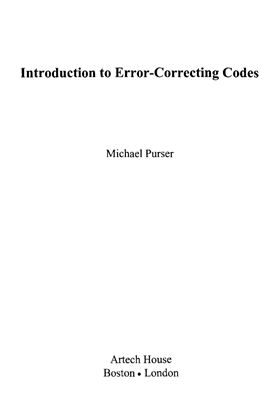Издательство Artech House, 1995, -133 pp.
This book aims to be an introduction to the topic of error-correcting codes, a topic of major importance in digital communication whenever accuracy is critical. There are several excellent specialist textbooks (and one or two almost unreadable ones) on the subject, in addition to innumerable articles and papers in the jouals. Despite this, the basics of digital error detection and correction are unfamiliar to many who might easily understand them, even when they rely on those techniques in much of their professional work. In the author's opinion this situation arises from the lack of clear, concise introductory texts on the subject; and it is his hope that this book will be such a text.
There are at least three good reasons for studying the subject:
It is an ingenious and intellectually satisfying discipline in its own right
It is an application of branches of mathematics, notably that of finite fields, that gives stimulus to the study of those branches
It is a technology of immense practical use in computer and telecommunication systems
This book aims to illuminate all three of these aspects and, by presenting basic concepts and results, give the reader a firm grasp of the scope of the subject and a thorough understanding of the principal techniques. On this basis the reader should be able to pursue any future interest in more specialised areas of the subject without difficulty. There are many such areas.
The intended readership is the first-time student, whether one who is formally studying in a third-level institution or a computer or communications professional wishing to become familiar with the subject by self-education. Mathematical literacy is required, in particular familiarity with linear algebra, but no further exceptional ability or special knowledge is needed. The course of the book moves from the general concepts of block codes and distances (Chapter 1), through linear block codes (Chapter 2), to the special linear codes that are cyclic codes (Chapter 3) and the special cyclic codes that are BCH codes (Chapter 4).
By contrast Chapter 5 is devoted to Convolutional or Trellis Codes, in which data are in the form of an "infinite" stream, rather than a fixed-length block. Supporting mathematics is in the Appendices, so that those readers already familiar with, for example, finite fields can proceed through the main text directly.
Introduction
Linear Codes
Cyclic Codes
BCH Codes
Convolutional Codes
A Information Theory
B Some Binomial Approximations
C Finite Fields
D The Berlekamp-Massey Algorithm
This book aims to be an introduction to the topic of error-correcting codes, a topic of major importance in digital communication whenever accuracy is critical. There are several excellent specialist textbooks (and one or two almost unreadable ones) on the subject, in addition to innumerable articles and papers in the jouals. Despite this, the basics of digital error detection and correction are unfamiliar to many who might easily understand them, even when they rely on those techniques in much of their professional work. In the author's opinion this situation arises from the lack of clear, concise introductory texts on the subject; and it is his hope that this book will be such a text.
There are at least three good reasons for studying the subject:
It is an ingenious and intellectually satisfying discipline in its own right
It is an application of branches of mathematics, notably that of finite fields, that gives stimulus to the study of those branches
It is a technology of immense practical use in computer and telecommunication systems
This book aims to illuminate all three of these aspects and, by presenting basic concepts and results, give the reader a firm grasp of the scope of the subject and a thorough understanding of the principal techniques. On this basis the reader should be able to pursue any future interest in more specialised areas of the subject without difficulty. There are many such areas.
The intended readership is the first-time student, whether one who is formally studying in a third-level institution or a computer or communications professional wishing to become familiar with the subject by self-education. Mathematical literacy is required, in particular familiarity with linear algebra, but no further exceptional ability or special knowledge is needed. The course of the book moves from the general concepts of block codes and distances (Chapter 1), through linear block codes (Chapter 2), to the special linear codes that are cyclic codes (Chapter 3) and the special cyclic codes that are BCH codes (Chapter 4).
By contrast Chapter 5 is devoted to Convolutional or Trellis Codes, in which data are in the form of an "infinite" stream, rather than a fixed-length block. Supporting mathematics is in the Appendices, so that those readers already familiar with, for example, finite fields can proceed through the main text directly.
Introduction
Linear Codes
Cyclic Codes
BCH Codes
Convolutional Codes
A Information Theory
B Some Binomial Approximations
C Finite Fields
D The Berlekamp-Massey Algorithm

